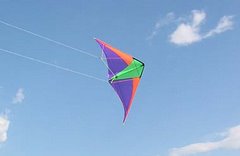Kites date back to as far as 3000 years ago, where they were made from bambou and silk in China. In the 19th Century, kites were used for scientific experiments. And in the 20th and 21st centuries, kites were used for military purposes...
Kites in Ancient China
Kites have made their appearance over three thousand years ago, in China. All the right materials were found there, for it's making: Bambou for the frame, and silk for the sail and bridle. It had a mythical and religious dimension. Later it was experimented as a science instrument for various researches. From China, the kite was reproduced throughout Asia, then later, in Europe, and now, in the modern age, in America, Australia and other countries.
Kites in Ancient China
Kites have made their appearance over three thousand years ago, in China. All the right materials were found there, for it's making: Bambou for the frame, and silk for the sail and bridle. It had a mythical and religious dimension. Later it was experimented as a science instrument for various researches. From China, the kite was reproduced throughout Asia, then later, in Europe, and now, in the modern age, in America, Australia and other countries.
Kites and Science
American diplomat and scientist Benjamin Franklin experimented with kites to investigate atmospheric electricity, and kite studies were also made by the American physicist and inventor Alexander Graham Bell.
Beginning in the 1890's and continuing for about 40 years, box kites, consisting of two or more connected open-ended boxes, were used for sending meteorologic instruments aloft to measure wind velocity, temperature, barometric pressure, and humidity.
Kites and the development of Transport
On November 12, 1894, Lawrence Hargrave was lifted from the ground by a train of four of his "cellular kites". This was simply one stage in his quest for a stable lifting surface which could then be powered and used as a means of transportation. Hargrave was doing his utmost to invent the aeroplane!
Hargrave developed several styles of kites and gliders, refined and developed the concept of curved surface wings, and also invented the rotary engine. He never patented any of his inventions, preferring them to be available for the advancement of mankind. He made scathing attacks on people who experimented in secrecy with the intention of profiting from their inventions, accusing them of trying to exploit humanity.
On November 7 1903, Samuel Franklin Cody actually crossed the English Channel on a vessel towed by kites.
Kites during War
In the late 19th and early 20th centuries, kites were used for lifting military observers to heights from which they could observe the disposition of enemy forces.
During World War II (1939-1945), kites were also used as gunnery targets.
French Military kites have long been popular with kitefliers. Their lifting power and stability make them ideal for high altitude flying.

No comments:
Post a Comment